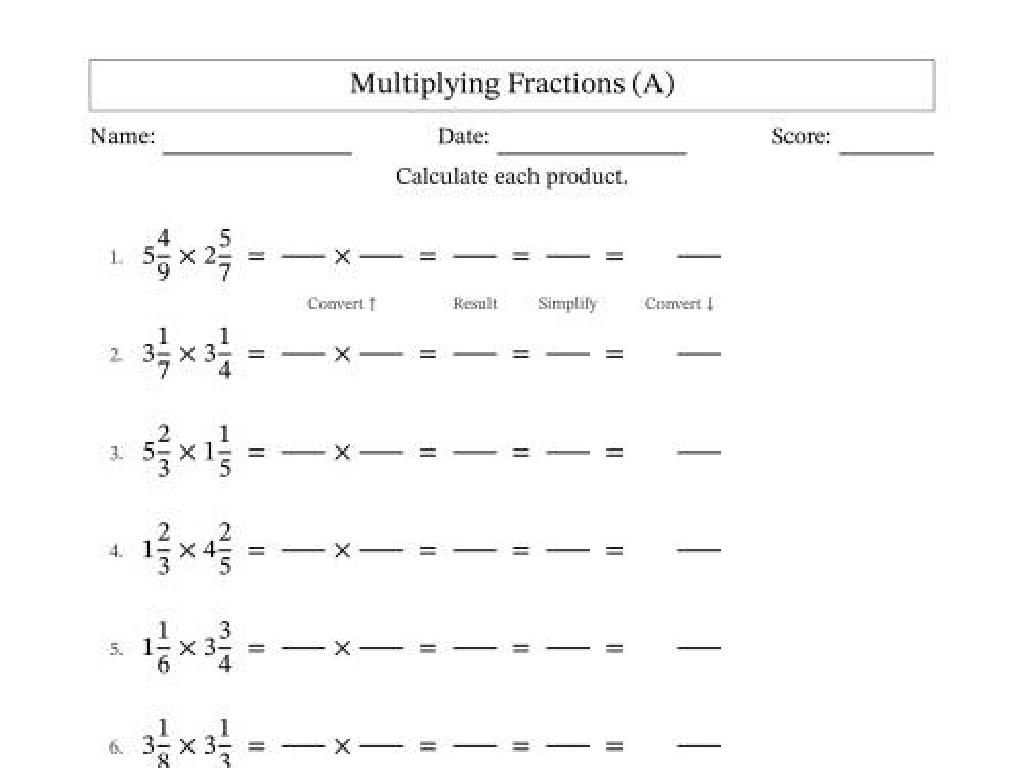How Does Particle Motion Affect Temperature?
Subject: Science
Grade: Eighth grade
Topic: Particle Motion And Energy
Please LOG IN to download the presentation. Access is available to registered users only.
View More Content
Particle Motion and Energy: Temperature Connection
– Basics of particle motion
– Particles move constantly and randomly
– Particle motion & temperature
– Faster motion means higher temperature
– Explore motion-temperature link
– We’ll see how energy affects particle speed
– Today’s learning objective
|
This slide introduces the fundamental concept that the motion of particles is intrinsically linked to temperature. Begin by explaining that all matter is made up of particles that are in constant, random motion. The speed of these particles is directly related to the temperature of the substance; the faster the particles move, the higher the temperature. During the lesson, students will explore how adding or removing energy from a system affects the speed of particle motion and, consequently, the temperature. The objective is to understand the relationship between particle motion and energy, and how this understanding is crucial for grasping broader concepts in physics and chemistry.
Particle Motion and Temperature
– Matter consists of particles
– Particle motion relates to temperature
– Particles move faster at higher temperatures, indicating more energy
– States of matter affect motion
– Solids have least particle motion, gases have the most
– Exploring temperature changes
– Heating or cooling matter changes particle speed and state
|
This slide introduces the concept of particle motion and its relationship with temperature, which is a fundamental principle in understanding the behavior of matter. All matter is composed of particles that are in constant motion, and this motion varies with temperature. The higher the temperature, the more energy particles have, causing them to move faster. This is observable in the different states of matter: solids, liquids, and gases, with solids having the least particle motion and gases having the most. When matter is heated, particles gain energy and move faster; when cooled, they lose energy and their motion slows down. This can lead to changes in the state of matter, such as melting or boiling. Encourage students to think about everyday examples of temperature affecting matter, like ice melting or water boiling, to solidify their understanding.
Temperature and Particle Motion
– Temperature: average kinetic energy
– Faster particles, higher temperature
– As particles move faster, they collide more, increasing the temperature.
– Ice melting: particles gain energy
– Ice absorbs energy, particles vibrate faster, leading to melting.
– Water boiling: rapid particle movement
– Boiling water: particles move so fast they break free from liquid to gas.
|
This slide aims to explain the relationship between particle motion and temperature. Temperature is a measure of the average kinetic energy of particles in a substance. When particles move faster, they have more kinetic energy, which results in a higher temperature. For example, ice melting occurs when particles within the ice gain enough energy to overcome their fixed positions and start to move more freely, leading to a phase change. Similarly, when water boils, the particles have so much energy that they can move rapidly and escape as steam. Encourage students to think of other examples where increased particle motion results in temperature changes, such as in hand warmers or when a car engine heats up.
Exploring States of Matter and Temperature
– Solids: Particles tightly packed
– Particles vibrate but don’t change position
– Liquids: Particles move past each other
– Particles have space to slide over one another
– Gases: Particles move freely
– Particles are spaced out and move rapidly
– Temperature’s role in particle motion
– Higher temperature increases particle motion
|
This slide introduces the concept of how particle motion affects temperature across different states of matter. In solids, particles are closely packed and only vibrate in place, which means they have low kinetic energy. As we move to liquids, the particles have more space to move, allowing them to slide past each other, indicating higher kinetic energy. In gases, particles are far apart and move freely at high speeds, showing the highest kinetic energy. Temperature is a measure of this kinetic energy; as temperature increases, particles move faster. This is a fundamental concept in understanding the behavior of matter in different states and is crucial for students to grasp the relationship between particle motion and temperature.
Investigating Heat Transfer
– Heat moves from warm to cool areas
– Heat energy naturally flows from hot objects to cold ones until they reach thermal equilibrium.
– Explore Conduction, Convection, Radiation
– Conduction: touching a hot pan. Convection: warm air rising from a heater. Radiation: feeling the sun’s warmth.
– Real-world heat transfer examples
– Examples: A spoon in hot tea gets warm (Conduction), wind patterns (Convection), Earth receiving heat from the sun (Radiation).
– Understanding heat flow
|
This slide introduces the concept of heat transfer, a key topic in understanding how particle motion affects temperature. Heat energy is always on the move, flowing from warmer objects to cooler ones until both reach the same temperature. Three mechanisms of heat transfer are conduction (direct contact), convection (fluid movement), and radiation (electromagnetic waves). Use everyday examples to illustrate these concepts: a metal spoon in hot tea, wind patterns caused by temperature differences, and feeling the sun’s warmth on your skin. Encourage students to think of other examples they’ve experienced. This understanding is fundamental in grasping how particle motion relates to energy and temperature changes.
Measuring Temperature: Understanding Thermometers
– Thermometers: Celsius & Fahrenheit
– Tools for measuring temperature, using different scales for different regions.
– Reading a thermometer correctly
– Learn the markings and what they represent on the scale.
– Estimating temperatures practice
– Guess the temperature in various real-life situations, like weather or cooking.
– Importance of accurate measurement
|
This slide introduces students to the concept of measuring temperature using thermometers. It’s crucial to explain the two most common temperature scales: Celsius, used mainly in science and internationally, and Fahrenheit, used in the United States for everyday applications. Demonstrate how to read a thermometer, emphasizing the importance of understanding the scale and the increments. Engage students with practical activities where they estimate temperatures in different scenarios to apply their knowledge. This will help them grasp the concept of temperature measurement and its relevance in daily life and scientific exploration. Ensure to discuss why accurate temperature readings are essential in experiments and in understanding particle motion related to temperature.
Class Activity: Temperature vs. Particle Motion
– Measure water temperature in 3 states
– Observe particle motion in each state
– Ice has slow-moving particles, room temp water has faster particles, boiling water has the fastest
– Record observations
– Discuss particle motion changes
– How does particle speed vary with temperature?
|
In this experiment, students will actively engage in learning how temperature affects particle motion. Provide thermometers and samples of water in three states: solid (ice), liquid (room temperature), and gas (steam from boiling water). Students should measure and record the temperature of each state. They will observe the particle motion through visual aids or simulations, noting the differences in particle speed and spacing. After recording their observations, lead a discussion to connect how increased temperature results in increased particle motion. This activity will help students visualize the kinetic theory of matter and understand that temperature is a measure of the average kinetic energy of the particles in a substance.
Conclusion: Particle Motion & Temperature
– Recap: Particle motion affects temperature
Faster-moving particles generally mean higher temperature.
– Importance of this concept in science
Understanding this is crucial for grasping heat, energy transfer, and states of matter.
– Open floor for questions
– Engage in a group discussion
Let’s clarify doubts and explore ideas together.
|
As we conclude, revisit the core idea that the motion of particles is intrinsically linked to temperature. Emphasize that faster particle motion typically results in increased temperature. Highlight the significance of this concept as it forms the basis for understanding various scientific phenomena, including heat transfer and changes in states of matter. Encourage students to ask questions they may have, fostering an environment of curiosity and discussion. This recap solidifies their learning and ensures they grasp the fundamental principles before moving on to more complex topics.
Homework: Temperature’s Effect on Particle Motion
– Explain temperature’s impact on particles
– Discuss particle motion in states of matter
– Solids have tightly packed particles; liquids less so; gases are free-moving
– Include experiment examples
– Reference the observed changes in our class experiment with water
– Relate to everyday phenomena
– How does heating a pot of water show these changes?
|
This homework assignment aims to reinforce the concepts discussed in class about the relationship between temperature and particle motion. Students should write a paragraph that explains how increasing or decreasing temperature can affect the motion of particles in solids, liquids, and gases, with specific references to the experiment conducted in class. For example, they might describe how heating water causes the particles to move faster and eventually transition from a liquid to a gas (boiling). Encourage students to think critically about how this concept applies to everyday life, such as why a balloon might expand when heated. This will help them understand the practical implications of particle motion in different states of matter.





